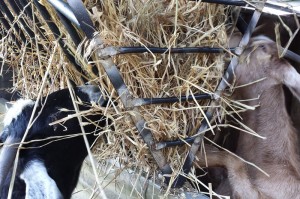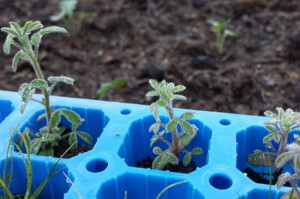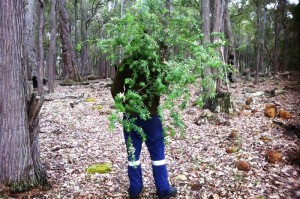Fodder Crops
 I don’t think there can be anything much more satisfying than watching Midge eat the oaten hay that we grew last year, knowing that she is converting it into kids and soon into milk. For the future, in addition to the oaten and meadow hay, we have planted some tagaste seeds as it is a preferred forage tree for goats (and catttle) and is like a miracle plant. (Wikipedia: Cytisus proliferus, tagasaste or tree lucerne, is a small spreading evergreen tree that grows 3-4m high. It is a member of the nitrogen fixing Fabaceae (pea) family and is indigenous to the dry volcanic slopes of the Canary Islands) . It does really well in the sandy soils of Australia and will grow pretty much anywhere, coping with rainfall ranging from 350 to 1600 mm annually.
I don’t think there can be anything much more satisfying than watching Midge eat the oaten hay that we grew last year, knowing that she is converting it into kids and soon into milk. For the future, in addition to the oaten and meadow hay, we have planted some tagaste seeds as it is a preferred forage tree for goats (and catttle) and is like a miracle plant. (Wikipedia: Cytisus proliferus, tagasaste or tree lucerne, is a small spreading evergreen tree that grows 3-4m high. It is a member of the nitrogen fixing Fabaceae (pea) family and is indigenous to the dry volcanic slopes of the Canary Islands) . It does really well in the sandy soils of Australia and will grow pretty much anywhere, coping with rainfall ranging from 350 to 1600 mm annually. There are over 100 000ha planted in Western Australia mainly for cattle and the Department of Agriculture is an enthusiastic supporter as “Farmer records demonstrated that tagasaste was the most resilient pasture in terms of maintaining a high carrying capacity over the extended drought periods of 2006–07″ and has lots of information available on it. round us, there are lots of tagasaste bushes growing along the road reserves and we are lucky enough to have a couple on the edge of our property. We have cut some branches for the goats a couple of times. We had to give Midge a vaccination needle so thought some tagasaste would take some of the pain away.
There are over 100 000ha planted in Western Australia mainly for cattle and the Department of Agriculture is an enthusiastic supporter as “Farmer records demonstrated that tagasaste was the most resilient pasture in terms of maintaining a high carrying capacity over the extended drought periods of 2006–07″ and has lots of information available on it. round us, there are lots of tagasaste bushes growing along the road reserves and we are lucky enough to have a couple on the edge of our property. We have cut some branches for the goats a couple of times. We had to give Midge a vaccination needle so thought some tagasaste would take some of the pain away.


Facebook